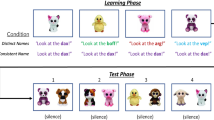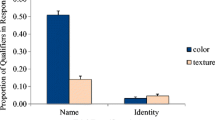Abstract
We investigated whether certain perceptual properties of objects could support children's and adults' judgments of the range of shape changes permissible for a named object. Three year-olds and adults saw a line drawing of a novel object and heard it named using a count noun (e.g., “This is a dax.”). Then they judged whether shape or size changes of the original could also be called by the same name (i.e., “Is this a dax?”). Children and adults extended the object name to the size changes. In contrast, extension to shape changes strongly depended on the particular characteristics of the objects. Objects with straight edges and sharp corners elicited very low generalization to shape changes, consistent with a “shape bias”. Objects with curved edges, curved and wrinkled edges, and curved and wrinkled edges plus “eyes” elicited increasingly broad generalization to the same shape changes. In a comparable No-Word task, children's and adults' judgments were similar across all different object types. The difference in generalization patterns over the two tasks suggests that only naming systematically engaged representations of the objects that could support inferences about their potential for shape change. The results are discussed in terms of the complex interactions of perception, ontology, and labelling in the development of object naming.
Similar content being viewed by others
References
Attneave, F. (1954). Some Informational Aspects of Visual Perception, Psychological Review 61: 183–193.
Baldwin, D. (1992). Clarifying the Role of Shape in Children's Taxonomic Assumption, Journal of Experimental Child Psychology.54: 392–416.
Biederman, I. (1987). Recognition by Components: A Theory of Human Image Understanding, Psychological Review.94: 115–147.
Binford, T.O. (1971). Visual Perception by Computer.Presented at IEEE Systems, Science and Cybernetics Conference, Miami, FL.
Becker, A. and Ward, T. (1991). Children's Use of Shape in Extending Novel Labels to Animate Objects: Identity versus Postural Change, Cognitive Development.6: 3–16.
Bloom, P. (1995). Intention, History, and Artifact Concepts. Cognition.60: 1–29.
Blum, H. (1973). Biological Shape and Visual Science (part 1), Journal of Theoretical Biology38: 205–287.
Brady, M. (1983). Criteria for Representations of Shape. In A. Rosenfeld and J. Beck (eds.), Human and Machine Vision: Vol. 1. Hillsdale, N.J.: Erlbaum.
DeLoache, J.S., Strauss, M.K. and Maynard, J. (1979). Picture Perception in Infancy, Infant Behavior and Development.2: 77–89.
Gelman, S. and Coley, J.D. (1991). Language and Categorization: The Acquisition of Natural Kind Terms. In S. Gelman and J.P. Byrnes (eds.), Perspectives on Language and Thought: Interrelations in Development. Cambridge: Cambridge University Press.
Gelman, S. and Medin, D. (1993). What's So Essential About Essentialism? A Different Perspectiveon the Interaction of Perception, Language, and Conceptual Knowledge, Cognitive Development.8: 157–167.
Gibson, E.J. and Walker, A.S. (1984). Development of Knowledge of Visual-Tactual Affordances of Substance, Child Development.55: 453–460.
Goldmeier, E. (1936). Uber anlichkeit bei gehenen Figuren, Psychologische Forschung.21: 146–209. (English translation by E. Goldmeier, Similarity in Visually Perceived Forms. Psychological Issues, 1972, 8(1), Monograph 29. New York: International Universities.
Hochberg, J. and Brooks, V. (1962). Pictorial Recognition as an Unlearned Ability: A Study of One Child's Performance, American Journal of Psychology.75: 624–628.
Hoffman, D. and Richards, W. (1984). Parts of Recognition. Cognition.18: 65–96.
Hollerbach, J.M. (1975). Hierarchical Shape Description of Objects by Selection and Modi-fication of Prototypes, AI Memo No. 346. MIT.
Imai,M., Gentner, D. and Uchida, N. (1994). Children's Theories ofWordMeaning: The Role of Shape Similarity in Early Acquisition, Cognitive Development.9(1): 45–76.
Jones, S. and Smith, L. (1992). The Place of Perception in Children's Concepts, Cognitive Development.8(2): 113–139.
Jones, S., Smith, L. and Landau, B. (1991) Object Properties and Knowledge in Early Lexical Learning, Child Development.62: 499–516.
Keil, F. (1989). Concepts, Kinds, and Cognitive Development. Cambridge,MA: MIT Press.
Keil, F. (1994). Explanation, Association, and the Acquisition of Word Meaning. In L.R. Gleitman and B. Landau (eds.), Acquisition of the Lexicon. Cambridge, MA: MIT Press.
Kourtzi, Z. and Shiffrar, M. (1999). The Visual Representation of Non-Rigidly Moving Objects. Manuscript submitted.
Landau, B., Smith, L. and Jones, S. (1988). The Importance of Shape in Early Lexical Learning, Cognitive Development.3: 299–321.
Landau, B., Smith, L. and Jones, S. (1992a). Perception, Ontology, and Naming in Young Children: Commentary on Soja, Carey, and Spelke, Cognition.43(1).
Landau, B., Smith, L. and Jones, S. (1992b). Syntactic Context and the Shape Bias in Children's and Adults' Lexical Learning, Journal of Memory and Language.31: 807–825.
Landau, B., Smith, L. and Jones, S. (1998a). Object Perception and Object Naming in Early Development, Trends in Cognitive Sciences.2(1): 19–24.
Landau, B., Smith, L. and Jones, S. (1998b). Object Shape, Object Function, and Object Name, Journal of Memory and Language.38(1): 1–27.
Landau, B. and Stecker, D.S. (1990). Objects and Places: Geometric and Syntactic Representations in Early Lexical Learning. Cognitive Development.5: 287–312.
Leyton, M. (1987). Inferring Causal History from Shape, Cognitive Science.13: 357–387.
Leyton, M. (1992). Symmetry, Causality, Mind. Cambridge, MA: MIT Press.
Lowe, D. (1985). Perceptual Organization and Visual Recognition. Boston: Kluwer Academic Publishers.
Mach, E. (1897). The Analysis of Sensations.(English translation, 1959). New York: Dover.
Mandler, J. and McDonough, L. (1993). Concept Formation in Infancy, Cognitive Development 8: 291–318.
Markman, E. and Hutchinson, J. (1984). Children's Sensitivity to Constraints on Word Meaning: Taxonomic versus Thematic Relations, Cognitive Psychology.20: 121–157.
Marr, D. and Vaina, L. (1982). Representation and Recognition of the Movements of Shapes, Proceedings of the Royal Society of London.214: 501–524.
Massey, C. and Gelman, R. (1988). Preschooler's Ability to Decide Whether a Photographed Unfamiliar Object Can Move Itself, Developmental Psychology.24(3): 307–317.
McCarrell, N.S. and Callanan, MA. (1995). Form-Function Correspondences in Children's Inference. Child Development.66: 532–546.
Medin, D., Goldstone, R. and Gentner, D. (1993). Respects for Similarity, Psychological Review.100(2): 254–278.
Michotte, A. (1963). The Perception of Causality. London: Methuen.
Mokhtarian, F. and Mackworth, A. (1986). Scale-Based Description and Recognition of Planar Curves and Two-Dimensional Shapes, IEEE Transactions on Pattern Analysis and Machine Intelligence.8: 34–43.
Murphy, G. and Medin, D. (1985). The Role of Theories in Conceptual Coherence, Psychological Review.92: 289–316.
Nackman, L. (1982). Three-Dimensional Shape Description Using the Symmetric Axis Transformation. Ph.D. dissertation, University of North Carolina at Chapel Hill.
Nosofsky, R. (1984). Choice, Similarity, and the Context of Classification, Journal of Experimental Psychology: Learning, Memory, and Cognition.10: 104–114.
Pizer, S.M., Oliver, W. and Bloomberg, S.H. (1986). Hierarchical Shape Description via the Multiresolution of the Symmetric Axis Transform, IEEE Transactions PAMI.9: 505–511.
Richards, W. and Hoffman, D.D. (1985). Codon Constraints on Closed 2D Shapes, Computer Vision, Graphics, and Image Processing.31: 265–281.
Rock, I. (1973). Orientation and Form..New York: Academic Press.
Rosch, E., Mervis, C.B., Gray, W.D., Johnson, D.M. and Boyes-Braem, P. (1976). Basic Objects in Natural Categories, Cognitive Psychology.8: 382–439.
Shepard, R. (1964). Attention and the Metric Structure of the Stimulus Space, Journal of Mathematical Psychology.1: 54–87.
Smith, L.B. and Heise, D. (1992). Perceptual development and Conceptual Structure. In B. Burns (ed.), Percepts, Concepts, and Categories.(pp. 243–296). Amsterdam: North-Holland.
Smith, L.B., Heise, D. and Rivera, S. (in progress). Surface Gradients in 12 Month-Olds' Discrimination of Animals versus Vehicles.
Smith, L.B., Jones, S. and Landau, B. (1992). Count Nouns, Adjectives, and Perceptual Properties in Novel Word Interpretations, Developmental Psychology.2: 273–286.
Smith, L.B., Jones, S. and Landau, B. (1996). Naming in Young Children: A Dumb Attentional Mechanism? Cognition.60(2): 143–171.
Soja, N., Carey, S. and Spelke, E. (1991). Ontological Categories Guide Young Children's Inductions of Word Meanings: Object Terms and Substance Terms, Cognition.38: 179–211.
Soja, N., Carey, S. and Spelke, E. (1992). Perception, Ontology, andWord Meaning, Cognition 45: 101–107.
Streri, A. and Spelke, E. (1988). Haptic Perception of Objects in Infancy. Cognitive Psychology 20: 1–23.
Tarr, M. and Pinker, S. (1989). Mental Rotation and Orientation Dependence in Shape Recognition, Cognitive Psychology.21: 233–282.
Van der Walle, G. and Hoerger, M. (1996). Perceptual Foundations of Categorization in Infancy. Poster Presented at the 10th Meeting of the International Conference on Infant Studies. Providence, RI, April.
Ward, T.B., Vela, E., Peery, M.L., Lewis, S., Bauer, N.K. and Klint, K. (1989). What Makes a Vibble a Vibble: A Developmental Study of Category Generalization, Child Development 60: 214–224.
Waxman, S. and Markow, D (1995). Words as an Invitation to Form Categories: Evidence from 12 to 13 month-old infants, Cognitive Psychology.3: 257–302.
Wiser, M. (1981). The Role of Intrinsic Axes in Shape Recognition. Proceedings of the Third Annual Conference of the Cognitive Science Society: 184–186.
Witkin, A.P. (1983). Scale-Space Filtering. Proceedings of the International Joint Conference on Artificial Intelligence. Karlsruhe, Germany, pp. 1019–1022.
Author information
Authors and Affiliations
Rights and permissions
About this article
Cite this article
Landau, B., Leyton, M. Perception, object kind, and object naming. Spatial Cognition and Computation 1, 1–29 (1999). https://doi.org/10.1023/A:1010073227203
Issue Date:
DOI: https://doi.org/10.1023/A:1010073227203




